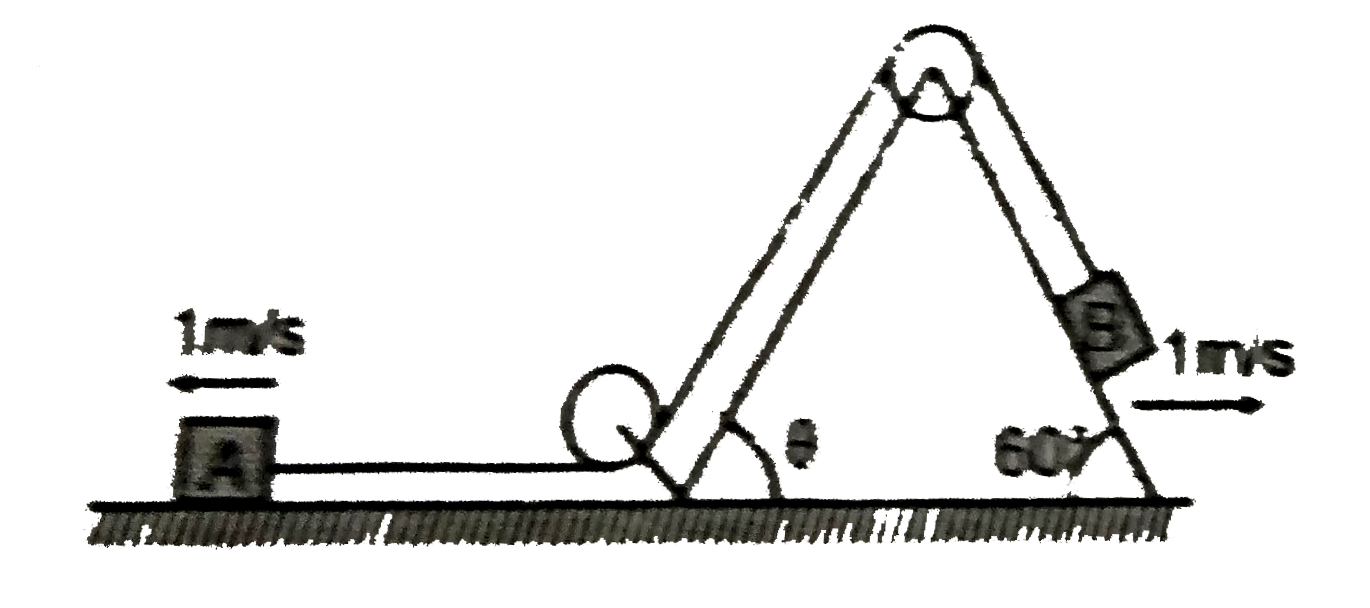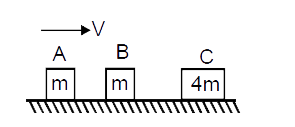Three blocks A, B and C each of mass m are placed on a surface as shown in the figure. Blocks B and C are initialyy at rest. Block A is moving to the right with speed v. It collides with block B and stricks to it. The A-B combination collides elastically with block C. Which of the following statement is (are) true about the velocity, of block B and C.

Velocity of the block C after collision is 2/3v towards right
Velocity of the A−B combination after collision is v3 towards left
Velocity of the A−B combination after collision is 23v towards left
Velocity of the block C after collision is v3 towards right.
The correct Answer is:A
v1=(m1−m2)(m1+m2)u1+(2m2m1+m2)u2
v2=2m1(m1+m2)u1+(m2−m1m1+m2)u2
for C:cc=2mu3m=23u
Topper's Solved these Questions
- CENTRE OF MASSBook:ALLENChapter:CENTRE OF MASSExercise:EXERCISE-III
Explore 42 Videos
- CENTRE OF MASSBook:ALLENChapter:CENTRE OF MASSExercise:EXERCISE-IV A
Explore 32 Videos
- CENTRE OF MASSBook:ALLENChapter:CENTRE OF MASSExercise:EXERCISE-I
Explore 40 Videos
- BASIC MATHEMATICS USED IN PHYSICS &VECTORS Book:ALLENChapter:BASIC MATHEMATICS USED IN PHYSICS &VECTORS Exercise:EXERCISE-IV ASSERTION & REASON
Explore 11 Videos
- ELASTICITY, SURFACE TENSION AND FLUID MECHANICSBook:ALLENChapter:ELASTICITY, SURFACE TENSION AND FLUID MECHANICSExercise:Exercise 5 B (Integer Type Questions)
Explore 3 Videos
Similar Questions
Three blocked A,B and C are placed one over the other as shown in figure. Draw free body diagram of all the three blocks.

View SolutionThree triangular blocks A,B and C of equal masses ‘m’ are arranged as shown in figure. Draw F.B.D. of blocks A,B and C. Indicate action– reaction pair between A,B and B,C.

View Solution
Knowledge Check
Three blocks A,B and C are suspended as shown in the figure. Mass of each block A and C is m. if the system is in equilibrium and mass of B is M, then
 AM=2mBM<2mCM>2mDM=m.
AM=2mBM<2mCM>2mDM=m.A system is shown in the figure. Block A is moving with 1m/s towards left. Wedge is moving with 1m/s towards right. Then speed of the block B will be :
 A1m/sB2m/sC√3m/sDnone of these
A1m/sB2m/sC√3m/sDnone of theseThree blocks are initially placed as shown in the figure. Block A has mass m and initial velocity v to the right. Block B with mass m and block C with mass 4 m are both initially at rest. Neglect friction. All collisions are elastic. The final velocity of block A is
 A0.6v to the leftB1.4v to the leftCv to the letD0.4v to the right
A0.6v to the leftB1.4v to the leftCv to the letD0.4v to the right
Three blocks are initially placed as shown in the figure. Block A has mass m and initial velocity v to the right. Block B with mass m and block C with mass 4 m are both initially at rest. Neglect friction. All collisions are elastic. The final velocity of block A is

View SolutionThree blocks A, B and C are lying on a smooth horizontal surface, as shown in the figure. A and B have equal masses, m while C has mass M. Block A is given an inita speed v towards B due to which it collides with B perfectly inelastically. The combined mass collides with C, also perfectly inelastically 56th of the initial kinetic energy is lost in whole process. What is balue of M//M?

View SolutionFind the acceleration of block B as shown in fig. (a) and (b) relative to block A and relative to ground if block A is moving toward right with acceleration a.

View SolutionThree blocks , labeled A , B and C , are floating in water as shown in the figure . Blocks A and B have the same mass and volume . Block C has the same volume , but is submerged to a greater depth than the other two blocks . Which one of the following statements concerning this situation is false ?

View SolutionThree blocks A,B, and C are suspended as shown in fig. Mass of each of blocks A and B is m. If the system is in equilibrium, and mass of C is M then

View Solution

